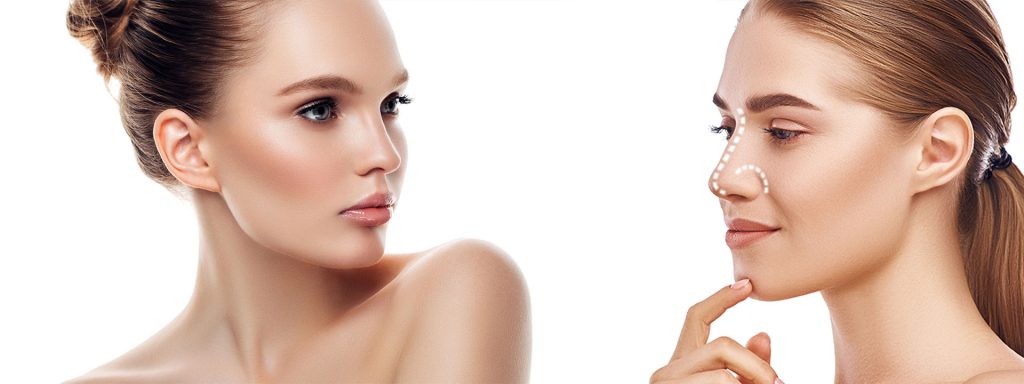Rhinoplasty, also known as a nose job, is a one of the most popular cosmetic surgery procedure that able to greatly improve the appearance of the nose and the whole face. Many people choose to undergo rhinoplasty in order to correct a nose that is too large, too small, or misshapen in some way. The procedure can make a significant difference in the overall appearance of the face, and has the potential to boost confidence and self-esteem.
In this article, we will be discussing the different aspects of rhinoplasty, including the different types of procedures, the recovery process, and the cost of the surgery. We will also be discussing the difference between open and closed rhinoplasty, as well as the relatively new technique known as dorsal preservation rhinoplasty. We will also be exploring the use of ultrasonic technology in rhinoplasty. So, let’s begin with what is rhinoplasty is and how it is done.

Table of Contents
What Is Rhinoplasty Surgery And How Is It Done?
Rhinoplasty, also known as a nose job, is a surgical procedure that is used to alter the shape, size, and overall appearance of the nose. Nose aesthetics should performed by a qualified plastic surgeon, who uses a combination of surgical techniques and specialized instruments to reshape the nose in a way that is aesthetically pleasing and in harmony with the rest of the face.
Rhinoplasty is a very popular cosmetic surgery procedure, and is often sought by individuals who are unhappy with the shape or size of their nose, or who have a nasal deformity that affects their breathing or overall health.
The specific techniques used during a rhinoplasty procedure will vary depending on the individual’s specific needs and goals. However, the general steps of the procedure are similar for most patients.
Once the desired shape has been achieved, the surgeon will close the incisions and apply a bandage to help protect the nose during the healing process. In preservation rhinoplasty there are no need of internal or external splints according the surgeon’s technique. Only skin colored tapes would be applied in this situation. The entire procedure typically takes around two hours, and is performed under general anesthesia in comfort.
What Is The Difference Between Open And Closed Rhinoplasty?
One of the key decisions that must be made before undergoing a rhinoplasty procedure is whether to choose an open or closed technique. The main difference between these two approaches is the location of the incisions made during the surgery.
First, for the closed rhinoplasty technique, plastic surgeon will make a small incision inside the nostrils. For open rhinoplasty starts with the incision along the columella (the strip of skin that separates the nostrils) and this incision becomes visible scar in time. There is no visible scar in closed rhinoplasty. The surgeon will then carefully reshape the underlying bone and cartilage, using specialized instruments to remove or add tissue as needed.
Each approach has its own advantages and disadvantages, and the right choice will depend on the individual’s specific needs and goals. In general, closed rhinoplasty is less invasive and has a shorter recovery time, and it’s possible to perform closed rhinoplasty for each individual by well-trained surgeon.
Open rhinoplasty, on the other hand, allows for more precision and control, but may require a longer recovery period. It is important for individuals considering rhinoplasty to discuss their options with a qualified plastic surgeon, in order to make an informed decision about the best approach for their unique situation.

What Is Dorsal Preservation Rhinoplasty?
Dorsal preservation rhinoplasty is a surgical technique that preserves the integrity of the nasal structure while reshaping the nose. The plastic surgeon carefully reshapes the underlying bone and cartilage to preserve the nasal structure and support. This can result in a more natural-looking outcome.
In preservation rhinoplasty technique or concept, most of cases are not needed internal or external splints. Only skin tapes would be applied just after the surgery, which means the patient is able to meet new nose right after.

What Is Ultrasonic Rhinoplasty?
Ultrasonic rhinoplasty is a surgical technique that uses high-frequency sound waves to reshape the underlying bone structures of the nose. While the ultrasonic energy reshapes bone, the plastic surgeon could make precise changes to the nose with less invasiveness. This technique may result in less swelling and bruising than traditional methods. It is a newer approach and not suitable for all patients, but can be effective for those looking to make subtle changes to their nose without a more invasive procedure.
Rhinoplasty Recovery
Rhinoplasty recovery can vary, but most patients can expect some swelling, bruising, and discomfort during the first few days. Pain medication can help manage discomfort, and cold compresses can reduce swelling. Patients should avoid strenuous activity and heavy lifting for at least a week, and avoid blowing their nose or bending over for several weeks.
Most patients are able to return to work and other activities within a week or two, although strenuous exercise and contact sports should be avoided for several weeks. Following the plastic surgeon’s instructions for post-operative care is important for optimal recovery. Over time, the swelling will subside and the final results will become more apparent. Most patients are happy with their results and find that their improved appearance boosts their confidence and self-esteem.
Rhinoplasty Price
The cost of rhinoplasty can vary depending on a number of factors, including the plastic surgeon’s experience and reputation, the complexity of the procedure, and the geographic location of the practice. In general, the cost of a rhinoplasty procedure can range from around $1,500 to $8,000, although more complex or extensive procedures may cost more. Some insurance plans may cover the cost of rhinoplasty if it is performed for medical reasons, not for aesthetic purposes, such as to improve breathing or to correct a deformity.









